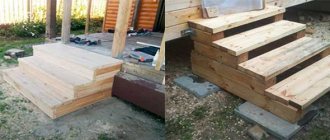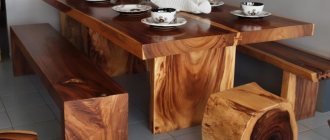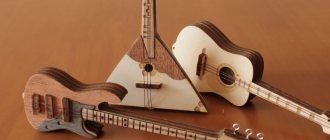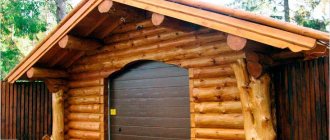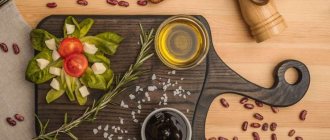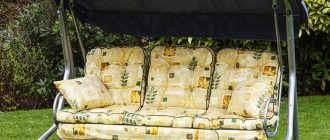Using things made with your own hands is always doubly pleasant. Especially if this thing is made taking into account individual requirements for it. And even if we are talking about such a simple item as a DIY wooden kitchen cutting board. It would seem that take any sanded board or piece of plywood and use it - what difference does it make what you use to cut bread or meat? But the daily routine of cooking becomes less burdensome when you do it using beautiful and convenient tools.
DIY wooden cutting board
And the cutting board is not as simple as it seems. And one is usually not enough; you need at least three for different products. Therefore, many will be interested in learning about the features of choosing and making it yourself.
The history of the origin of the cutting board
Original wooden cutting boards
Selection of material for manufacturing
We sweep away plastic, ceramics and glass immediately. And not only because these materials are difficult to process manually. But also because of their high hardness and negative impact on the knife blade, which quickly becomes dull when in contact with such surfaces.
Cutting board materials
Let's focus on wood, as a natural, beautiful and pliable material, most suitable for our purpose.
What products is it suitable for?
First of all, you should know that you cannot cut all types of products on one surface. There should be a separate board for meat products, fish, vegetables and fruits, cheese and baked goods. If you cut raw vegetables for salad after cutting meat, there is a risk of bacteria and parasites entering the human body. This can happen even if the surface is thoroughly washed with a special product. Another argument in favor of having multiple surfaces: after using a particular product, a specific odor remains, which is transferred to other products during subsequent use. The aroma and taste of dishes can be spoiled if food is cut on one board. Some housewives wipe the surface with fresh lemon or a cotton pad soaked in vinegar, but this folk method does not always completely eliminate unnecessary odors. This is why it is advisable to purchase several wooden surfaces for cutting different products.
What can be carved on wooden planks:
- Meat and fish products;
- Sausages, cheeses;
- Vegetables, greens;
- Fruits;
- Bread.
You can separately purchase boards for rolling out dough, as well as for chopping onions and garlic.
Dimensions and shape
The dimensions of the wooden block are also of great importance. They are determined based on the required dimensions of the finished product, taking into account the method of its manufacture and waste from trimming.
The dimensions of the board, in turn, depend on its purpose. If a small board is enough for cutting cheese or fruit, then for cutting meat it should not only be large, but also thick enough to withstand the blows of a kitchen hatchet.
Cutting board for chopping meat
Cutting board for cutting baguettes
However, you should also take into account the dimensions of the kitchen workplace. A large board will be of little use if it simply does not fit on the countertop between the stove and the sink, for example.
The cutting board must match the dimensions of the countertop on which food is cut.
This applies not only to products for working purposes, but also for decorative purposes. After all, quite often they are made exclusively as decoration for the kitchen interior, and not for their intended purpose. Decorated with carvings, paintings or appliques, such accessories are an integral part of kitchens in a rustic or Provencal style.
Decorative carved cutting board
Wood painting
The dimensions and shape of the board should be such that it is convenient not only to use, but also to store. For example, when storing in a hanging position, a hole must be provided. It can be located in the middle or in the corner of a rectangular product or in the center of a long handle.
Storing cutting boards
Cutting board storage stand
The golf course has many surprises in store. Holes are hidden somewhere, kitchen knives are hidden somewhere
If the product will be used not only for cutting and cutting food, but also for serving, it is worth giving it a non-standard shape.
Cutting boards for the sink
Is registration required?
If you make 2-3 boards a month for sale, this is considered not a business, but a hobby, which does not require official registration. But if you plan large-scale production with the involvement of hired workers, you need to register your activities as an individual entrepreneur.
To do this, you need to contact the tax service with a certain set of documents:
- copy of passport;
- a receipt for payment of the duty;
- application in form P21001.
Finally, the taxation system is selected. A simplified version or purchasing a patent is preferable.
Types of wooden boards by manufacturing method
Based on manufacturing technology, these kitchen accessories are divided into solid and glued. The first ones are cut according to a template from a single piece of wood (a wide board or a cross-section of wood) and processed.
Solid wood cutting board
Puzzle cutting boards
Glued boards can be assembled from longitudinal bars, end cuts or various shapes like puzzles or mosaics. They are more durable and practical, as they are less susceptible to internal stress and deformation.
Glued end cutting boards
For reference! Particularly valued are the so-called end boards, in which the wood fibers are located not along the working surface, but perpendicular to it. When cutting, the knife blade does not bump into hard fibers, but seems to fall between them, so it remains sharp longer and requires sharpening less often.
How to make an end cutting board
In this case, the manufacturing process will be a little more complicated, because much more work will be required with wood. You should use cuttings from fairly hard wood species, for example, pine or oak. They should not be affected by diseases such as fungus, and they should not have knots or cracks.
The blanks will be processed on a jointer, and then strips 2.8 cm wide will be cut. The number of parts made of oak and pine should be the same. When the blanks are made, use a jointer and sandpaper to grind the parts down to a size of 2.5 cm, and lay the pieces one by one.
Next, we glue all the blanks together to create a solid product, and here it is important to note the fact that you cannot use an adhesive composition that contains formaldehyde. It is also not worth using epoxy compounds, and most often use PVA-based substances. The main advantage of such boards is that they are much stronger than ordinary ones, which are made of solid wood. In addition, end cutting boards are much less likely to dull knives during use.
DIY making
Below are examples of how to make wooden cutting boards yourself.
Solid boards
First you need to choose the size and shape of the board. If it has a complex configuration, you will need a paper template, drawn to a real scale by hand or in a computer program, and then printed on a printer. It’s easy to transfer it to the board by cutting it out and tracing the outline with a pencil.
Transferring the template to the board
Advice! If the product has a symmetrical shape relative to the axis, it is enough to draw half of the figure on a sheet folded in half, and then cut it out, using scissors to grab both layers of paper.
In addition to the wooden blank itself, you need to buy beeswax and oil to impregnate the board. It will give the wood a more pronounced texture and rich color and will protect it from moisture. You can use special mineral oil to impregnate countertops. But flaxseed or Vaseline bought at the pharmacy will do.
Oil
As for tools, you don’t need anything special to make a solid wood board. Of course, if you have a planer, sander and jointer, circular saw, router and jigsaw, the job will be done quickly and effortlessly. But it is quite possible to get by with a hand jigsaw and sandpaper, especially if the shape of the product is simple, without small radius elements.
If all this is available, you can get started.
Step 1. We transfer the outline of the future product onto a wooden blank and cut it out with a jigsaw or a hacksaw for metal with a fine tooth - it does not make large chips.
Sawing the workpiece
Step 2. Using sandpaper, a file or a grinder, we process the planes and ends of the board, eliminating broken chips and wood fibers and making the product smooth.
Grinding
Step 3. If you have a router, you can use it to round the edges or cut a hollow around the perimeter.
End processing with a router
Step 4. Drill a hole and process its edges.
Drilling a hole
Step 5. If this is provided for by the project, we decorate the board with carvings, paintings or other means, keeping in mind the purpose of the product. If this is an applied accessory, it is better to decorate only one side. A drawing or carved ornament is allowed on the working surface only around the perimeter or in a small area at the edge.
Wood carving
Step 6. Treatment with a protective composition. Since food comes into contact with the cutting board, it cannot be coated with varnish or other synthetic compounds. It is better to use the oils listed above to impregnate wood, applying them with a brush, sponge or piece of lint-free cloth. The number of layers depends on the absorbency of the wood. Each layer should be given time to dry and absorb, after which you should walk over the surface with the softest sandpaper. The last layer is applied with a mixture of oil and melted beeswax in a ratio of 3:1. If it is not completely absorbed, it is heated with a hairdryer and the excess is wiped off with a paper napkin.
Treatment with a protective composition
Video - Wooden cutting boards
As a starting material, you can use not only boards, but also plywood, furniture panels, and transverse cuts of wood.
Tools for work
To make a plywood board quickly and efficiently, you need to use the appropriate tools. If the work on making a kitchen product is being done for the first time, questions may arise regarding tools.
To make the simplest board you will need the following tools:
- If you think about how to cut plywood, then the ideal option would be a manual or electric jigsaw.
- To form the holes you will need a drill with a set of wood drill bits.
- A set of sandpaper with different degrees of grain.
- Sander.
- Milling machine.
- Rasp.
The set of tools for decorative finishing depends on how and with what the product will be decorated. Array
Details
It is very important to pay attention to some details. The hole for hanging the board is cut last, and the edges need to be sanded. At this stage, you also need to decorate the surface, if necessary. You can use patterns such as burning, sawing, or painting.
You should pay attention to the fact that for a cutting board, the pattern means that food will be clogged into it. Therefore, the depth of the pattern should be minimal, and it should be located along the edges and not in the center.
